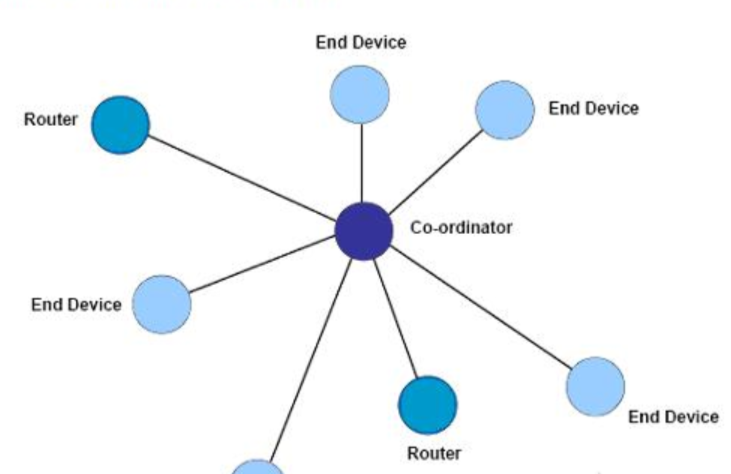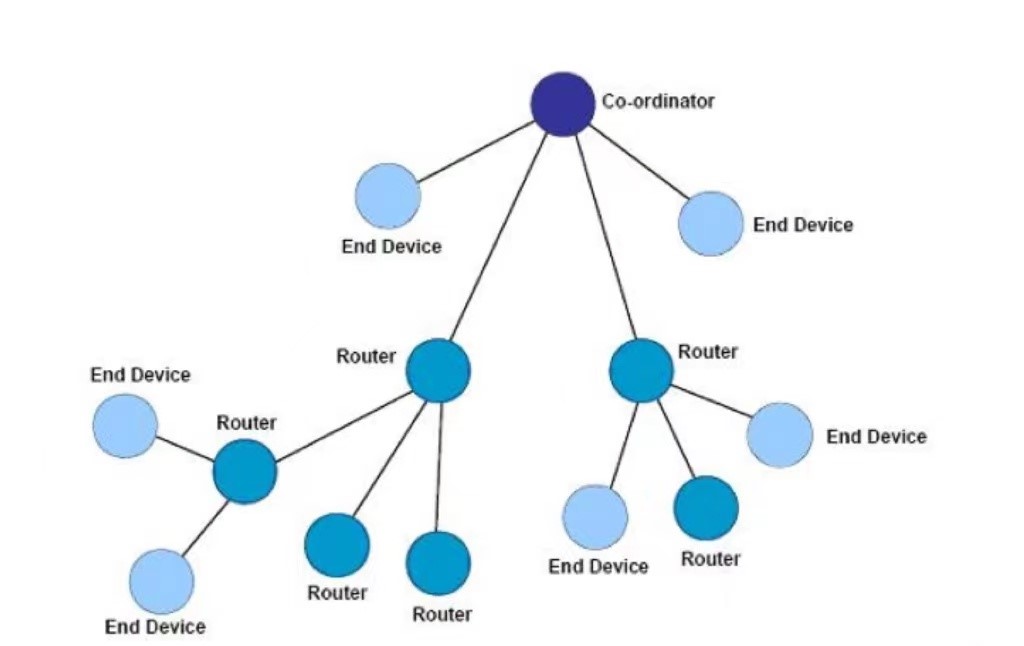As a wireless network technology with short distance, low power consumption and low data transmission rate, ZigBee is a technical solution between wireless tag technology and Bluetooth technology. The reason why ZigBee can be widely used in sensor networks and other fields , thanks to its powerful networking capability, it can form three types of ZigBee networks, such as star network, tree network and mesh network. According to the actual development project needs, the appropriate ZigBee network structure can be selected for networking. The three ZigBee network structures also have their own merits. Беспроводной модем LoRa
Star topology

The star topology is the simplest of the three topology structures. It includes a Co-ordinator (central coordinator) node and multiple End Device (terminal) nodes. Each End Device (terminal) node can only communicate with the Co-ordinator (coordinator) node, and cannot link to other End Device (terminal) nodes. If you need to communicate with each other between two End Device (terminal) nodes, you must link the Co-ordinator (coordinator) node to receive and forward information.
This topology has a disadvantage: there is one and only one unique route for data transmission between nodes. The state of the Co-ordinator node may become the point of influence for the entire network. The networking implemented by the star network topology does not need to use the ZigBee network layer protocol, because the protocol layer of the IEEE 802.15.4 itself is already implemented on the basis of the star topology, but this increases the developer's ability in the application layer. work, including receiving, forwarding and other tasks that need to be processed by themselves.
Tree topology

The tree topology includes a Co-ordinator (coordinator) node and multiple Router (router) and End Device (terminal) nodes. Co-ordinator (coordinator) connects multiple Router (route) and End Device (terminal) nodes, and the router (route) of its child nodes can also connect multiple Router (route) and End Device (terminal) nodes, through this way Repeatedly stack multiple levels to form a tree-like network. The tree topology is shown in the figure:
have to be aware of is:
Co-ordinator nodes and Router nodes can have multiple connected child nodes.
But the End Device (terminal) node can no longer connect to other child nodes.
Nodes with the same parent (coordinator or router) can be called siblings
Nodes with the same grandparent (coordinator or router) can be called cousins
Communication rules in tree topology:
Each routing node can only communicate with its parent and child nodes.
If data needs to be sent from node to node, the information will be passed up the tree route to the nearest ancestor node, and then passed down to the target node.
The disadvantage of tree topology: There is only one routing channel for information. Moreover, the routing of information is processed through the protocol stack layer, and the entire communication routing process is relatively completely transparent to the application layer. Сервер с одним последовательным портом
Mesh topology
Mesh topology consists of a Co-ordinator node and multiple Router (routing) nodes and End Device (terminal) nodes. The Mesh network topology is roughly the same as the tree topology; however, based on the tree structure, the mesh network topology is a topology with more flexible communication routing rules. If possible, direct communication between routing nodes is possible. of. This routing mechanism makes the communication of information between nodes more efficient, and it also means that when a problem occurs in one routing path, information can also be automatically transmitted along other routes. A schematic diagram of a mesh topology is shown below:
The network of the MESH mesh network topology has very powerful functions, and the network can communicate in a "multi-level hop" way; and the MESH mesh network topology can also form a very complex network; Organization and self-healing functions.
Both star and tree networks are more suitable for point-to-multipoint and short transmission distance applications.


No comments yet